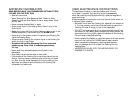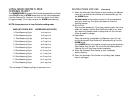10
WHY RICE?
Grains (including rice) are finally getting the attention they
deserve as they move into the nutritional spotlight. The new
USDA dietary recommendations highlight grains as an essential
part of a healthy, whole foods diet. With their impressive fiber,
complex carbohydrates and protein profiles, they are, without a
doubt, some of Mother Nature’s most perfect foods.
Grains are the edible portion of cereal plants. The grain or kernel
is technically a complete fruit and houses most of its nutritional
value. In addition to their high fiber content, grains are an
excellent source of B vitamins and many minerals, including
magnesium, iron, zinc, potassium and selenium. The germ oils
found in the germ layers of whole grains contain vitamin E, an
important antioxidant.
GRAIN GLOSSARY
Rice is a staple food in many countries. Although long-grain rice
is consumed more than any other rice around the world, it is
inferior to brown rice in both taste and nutrition. Brown rice is
not only more complete nutritionally, it has a wonderful nutty
aroma and flavor.
Polished rice (white) has been bleached, cleaned, pearled
(polished with talc), then often oiled and coated. This refining
process causes the loss of its hull, bran and germ, which are
removed from the grain (along with most of its nutrients) leaving
only the starchy endosperm. As white rice is rather bland when
eaten by itself, it is usually served under steamed or sauteed
vegetables and topped with a flavorful sauce, such as curry or
peanut.
Long grain brown rice contains fiber and the nutrient-rich bran
and germ, as well as the starchy endosperm. In addition to being
more flavorful, brown rice digests more slowly, which provides
energy over a longer period of time. Brown rice is a satisfying
meal companion and can even serve as the main focus for a
meal. While not as high in protein as wheat and some other
grains (10%), the high quality protein in brown rice is easily
utilized by the body. Brown rice is also a good source of the B
vitamins and serval minerals, including magnesium, potassium,
zinc, iron, and selenium.
9
COOKING RICE
GENERAL INFORMATION
Rice is grown on marshy land that floods easily. It does not need
to be milled or ground; only the outer husks must be removed,
leaving behind what is known as brown or whole rice, the most
nutritious of rices.
Information has recently been published about more healthful ways
to eat, by consuming less fat, less protein and more complex
carbohydrates in our diets. Because brown rice is about 8%
protein, 87% carbohydrates and almost no fat, it is a perfect
ingredient in a healthful diet.
Because rice is a valuable source of carbohydrates, it is starchy by
nature. To obtain fluffier, less starchy rice, you can rinse the rice
before cooking. But by rinsing or soaking the rice, you lose some of
the vitamins, which are water soluble. Please refer to your rice
package directions for specific instructions.
TYPES OF RICE
Brown Rice - Contains more vitamin B complex, iron and calcium
and takes longer to cook than white rice. Its flavor is nutty and its
texture is chewy. (See Cooking Chart.)
White Rice - Includes several kinds of white rice, most of which
can be prepared in your FARBERWARE® Automatic Rice Cooker.
Long-Grain Rice - Less starchy than short-grain rice, so it separates
into individual grains more than short-grain rice.
Short-Grain Rice - More moist and tender than long-grain rice. It
has a softer texture and starchier flavor.
White rice will take about 20-25 minutes to cook, (brown rice
approximately 50 minutes). When rice is done, the Selector Lever
will rise and the Automatic Rice Cooker will automatically go into
the WARM Mode. Allow rice to stand on WARM for 10 to 15
minutes to ensure fluffy rice. You can keep cooked rice on the
WARM setting for several hours without the taste of the rice being
affected. Do not remove Cover until ready to serve. The Cooking
Pot remains very hot after cooking or keeping warm. Use a pot
holder when handling.


















